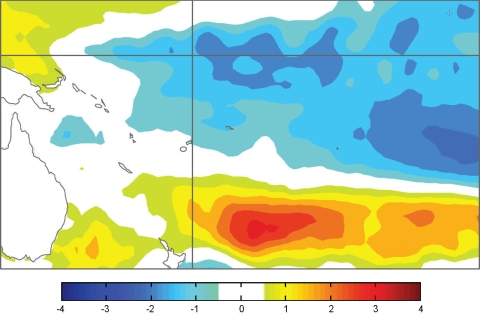Strong La Niña conditions exist in the tropical Pacific, but the event is now showing signs of easing.
Strong La Niña conditions exist in the tropical Pacific, but the event is now showing signs of easing. The three-month mean SOI for DJF 2010/11 was +2.3, the highest seasonal average for nearly 40 years (since Nov 1973–Jan 1974). However, monthly SOI values have dropped from the high of +2.8 in December 2010. Positive zonal wind anomalies have appeared over the far western Pacific, while negative anomalies over the central Pacific weakened in February. The TRMM ENSO index was –0.9 for the 30 days to 24 February, similar to the January value. Convection remains enhanced over the Maritime Continent and western Australia, and is strongly suppressed near the Equator in the western and central Pacific. The ITCZ and SPCZ both remain displaced poleward of their normal positions. NINO3 and NINO4 SST anomalies were around –1.0°C and –1.3°C respectively in February, a little weaker than their respective values of –1.2°C and –1.4°C in January. The Equatorial cold tongue is prominent in the SST anomaly field, now with largest amplitude in the central Pacific, while anomalies are close to zero near the South American coast. SST anomalies remain positive in the far western Pacific and in the extra–tropical Pacific of both hemispheres. The negative subsurface heat content anomaly in the eastern Pacific weakened in February and the positive anomaly in the western Pacific is now extending steadily eastwards. The MJO is currently very weak, and models are equivocal about any future development.
Approximately half the models NIWA monitor predict the tropical Pacific to remain in a La Niña state over the coming three months, while the rest indicate easing to a neutral (or neutral–cool) state. Almost all models are in the neutral range for austral winter, but a couple suggest a shift to warm conditions. The NCEP ENSO discussion of 10 February states that La Niña has started to weaken, and La Niña or neutral conditions are equally likely during May–June. The IRI summary of 17 February rates La Niña as reduced to moderate strength in February, but suggests a 74% probability for conditions continuing through March–May 2011, reducing below 50% through April–June 2011.

Surface temperature anomalies (ºC) for February 2011
